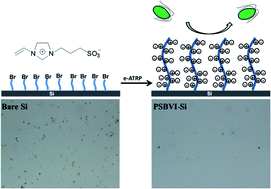Grafting zwitterionic polymer brushes via electrochemical surface-initiated atomic-transfer radical polymerization for anti-fouling applications
Abstract
Zwitterionic polymer brushes based on sulfobetaine vinylimidazole (pSBVI) were successfully grafted to silicon substrates by electrochemical surface-initiated atomic-transfer radical polymerization (e-SIATRP), and exhibited excellent anti-fouling activities because of the presence of the two bactericidal functional groups, imidazolium and sulfonate. Various characterization techniques, including atomic force microscopy, X-ray photoelectron spectroscopy and use of a quartz crystal microbalance, were employed to characterize the polymer brush-modified silicon substrates. Subsequently, the anti-bacterial and anti-biofouling activities of the polymer brush substrates were evaluated. The experimental results showed that the pSBVI effectively resisted the adhesion of Nannochloropsis maritima and showed good anti-bacterial activity against Escherichia coli. In addition, in comparison with poly(vinylimidazole) brush-modified substrates and the bare substrate, the pSBVI-based materials also exhibited excellent anti-adsorption performance against both bovine serum albumin and lysozyme.

- This article is part of the themed collection: 2014 Journal of Materials Chemistry B Hot Articles

 Please wait while we load your content...
Please wait while we load your content...